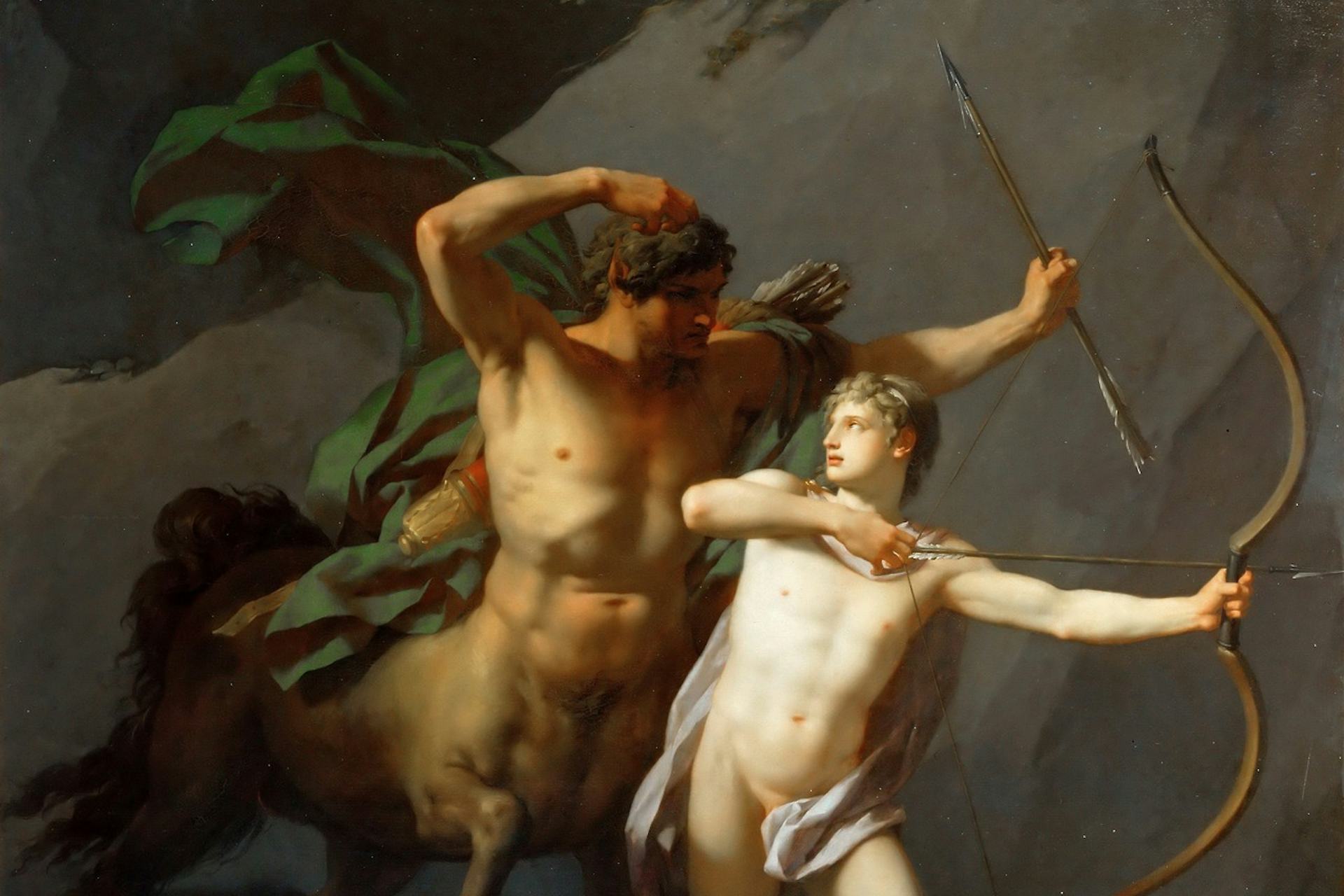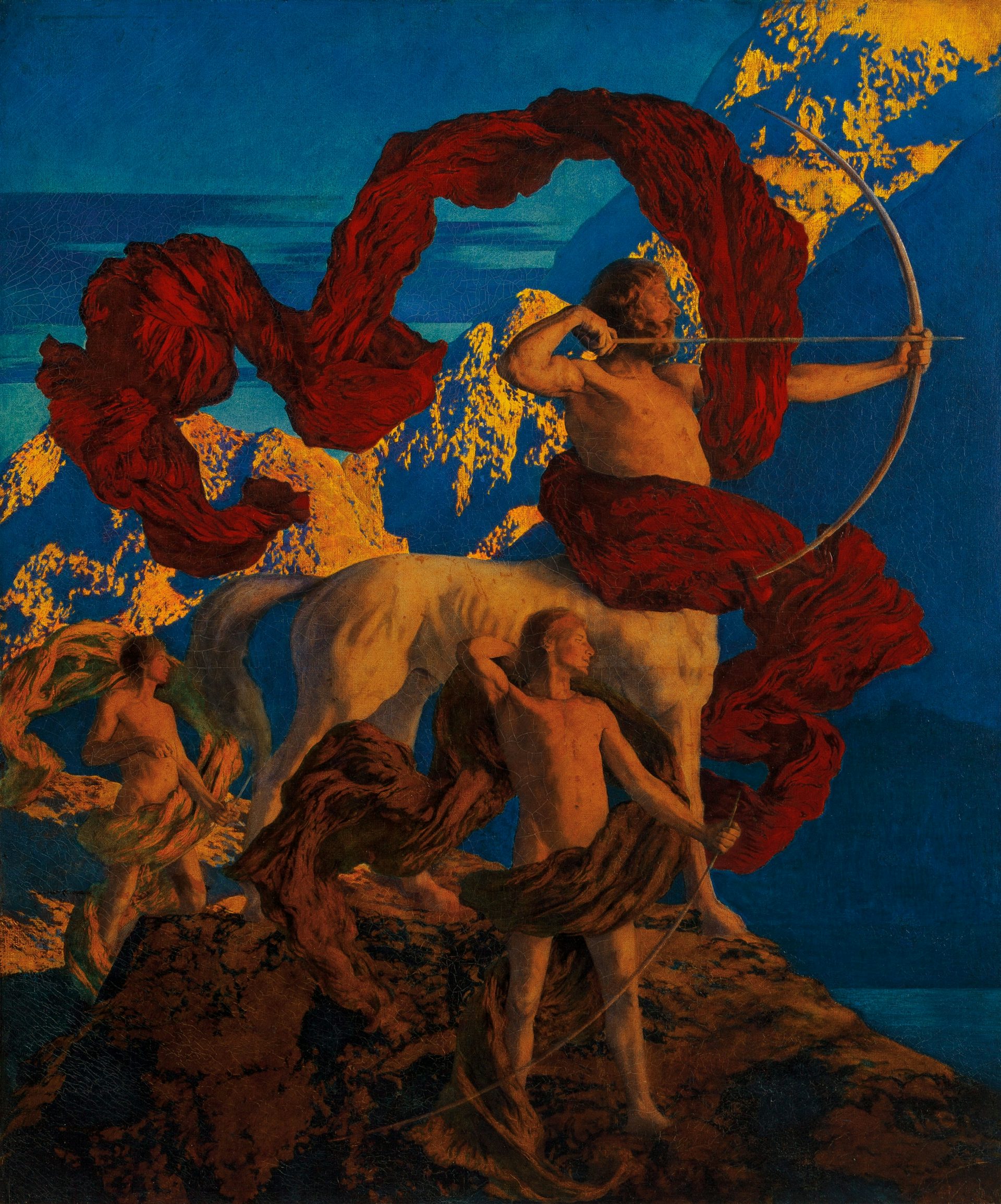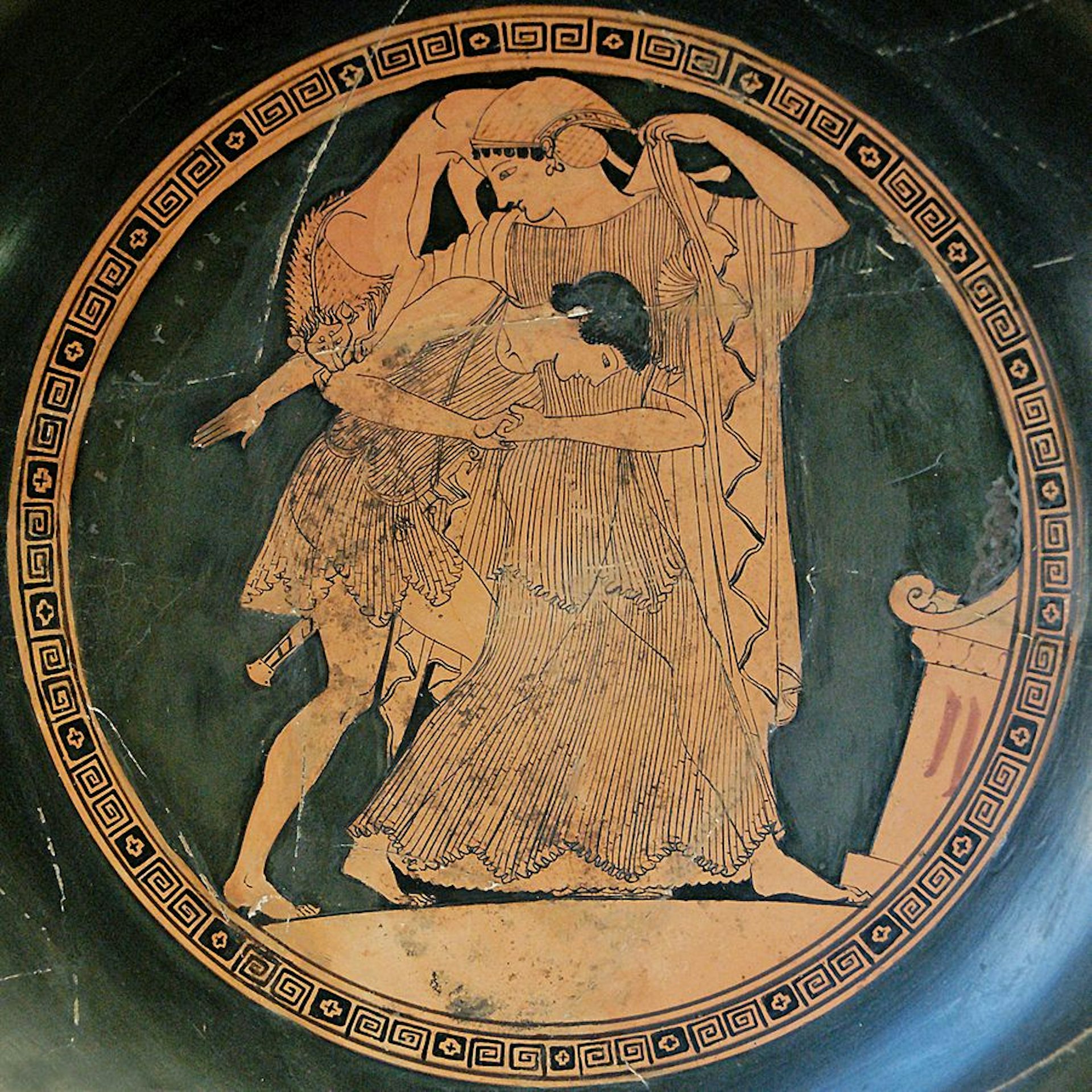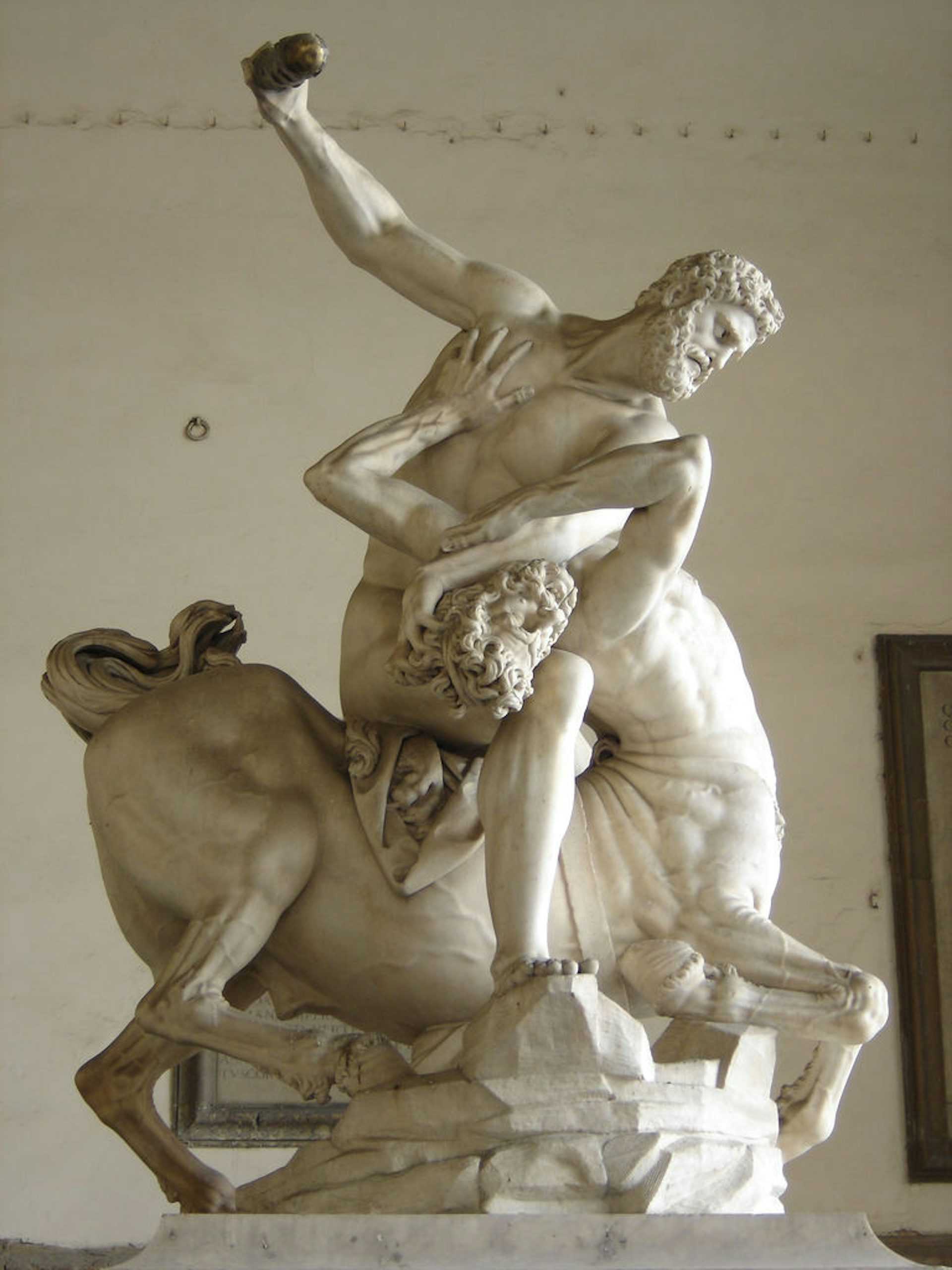Chiron

The Education of Achilles by Chiron by Jean-Baptiste Regnault (1782).
LouvrePublic DomainOverview
Wise Chiron, the son of Cronus and Philyra, was one of the Centaurs, a powerful race of part-man, part-horse creatures. While the other Centaurs were known for their violent and lecherous ways, Cronus was a gentle and helpful being. He was famously skilled in the arts of warfare, medicine, and music.
Chiron was honored by both gods and mortals and trained some of the greatest heroes of Greek mythology, including Jason, Asclepius, and Achilles. Chiron himself was immortal, though he ultimately gave up his immortality and was transformed into a constellation. He was long revered in the ancient Greek world as a champion of the arts and was sometimes even worshipped as a patron god of physicians.
Etymology
It is very likely that the name “Chiron” (Χείρων, translit. Cheírōn)—sometimes spelled “Cheiron”—came from the ancient Greek word χείρ (cheír), meaning “hand.”[1] Chiron can thus be translated as “he of the skillful hands,” a reference to his dexterity and diverse abilities.
Pronunciation
English
Greek
Chiron Χείρων (translit. Cheírōn) Phonetic
IPA
[KAHY-ron] /ˈkaɪ rɒn/
Titles and Epithets
In ancient literature, Chiron’s epithets usually highlighted his strength (e.g., ζαμενής/zamenḗs, “mighty”[2]) or his wisdom (e.g., βαθυμῆτα/bathymêta, “deep-thinking”[3]). Often he was simply called by his matronymic (that is, a title derived from his mother’s name): Φιλυρίδης (Philyrídēs, “son of Philyra”), or, in Latin, Philyreius.
Attributes
Locales
Chiron lived with the other Centaurs in Thessaly—primarily on Mount Pelion, on the northeastern coast of Greece. This was near cities such as Iolcus (the home of Jason) and Phthia (the home of Peleus and Achilles). It was also near the kingdom of the Lapiths, a warlike tribe.
After their famous battle with the Lapiths, the Centaurs were driven further south. It seems that Chiron went with them; many traditions suggest that Chiron’s death took place somewhere in the Peloponnesian region of Arcadia, probably around the Pholoe Range.
Appearance and Abilities
Like the other Centaurs, Chiron was part horse and part man, though these creatures’ form changed over time. In the more popular representation, they were human from the waist up with the body and four legs of a horse. But the original image was somewhat different, with the Centaurs appearing fully human from head to toe but with the trunk and hind legs of a horse growing out of their backside.
This double nature allowed the Centaurs to combine the raw physical strength of an animal with the intellect and reasoning of the human mind. Chiron, like the other Centaurs, was undeniably strong. But unlike his brutish brethren, who were notorious for their violent and lustful behavior, Chiron was famously wise and civilized. Homer described him as “the most righteous of the Centaurs,”[4] while Pindar wrote that his “mind was friendly to men.”[5]
Chiron’s knowledge was vast. He was probably known above all for his expertise in healing and medicine.[6] But various sources added that he was also knowledgeable in the arts of warfare, hunting, music, and even astronomy and the rules of ritual. Chiron trained many heroes—and perhaps even one or two gods—in these valuable arts.
Also unlike the other Centaurs, Chiron was immortal. Some sources even referred to him as a god (θεός/theós).[7] But this did not stop Chiron from eventually giving up his immortality and dying (see below).
Iconography
Ancient artists were usually careful to distinguish Chiron from the other Centaurs. By the end of the seventh century BCE, it had become standard practice to depict most Centaurs with the head, torso, and arms of a human and the body and four legs of a horse. But Chiron continued to be shown with a full human body, with only the rear half and two hind legs of a horse.
Moreover, while most Centaurs were shown with features that highlighted their animal nature (long animal ears, shaggy hair and beard, and a satyr-like snub nose), Chiron always had a gentle face, with his hair and beard elegantly groomed. Very often his human front was shown wearing human clothing.

Black-figure neck amphora showing Chiron (left) receiving the infant Achilles (center) from Peleus (right). Attributed to the Group of Würzburg 199 and the Antimenes Painter (ca. 520–510 BCE).
Walters Art MuseumCC0Though Chiron was originally depicted as more human than his brethren, in post-classical and Roman art it became increasingly common to represent him like the other Centaurs, with four horse legs.
Chiron was often shown in scenes with Peleus or Achilles (Peleus’ son).[8]
Family
Family Tree
Mythology
Chiron and the Gods
As the son of a Titan, Chiron was sometimes regarded as a god himself. He therefore spent time with the other great gods of the Greek pantheon. One writer, Xenophon, even recorded a tradition in which Chiron had been taught the art of hunting by the Olympian gods Apollo and Artemis.[17]
In another story, told by the poet Pindar, Apollo summoned the wise Chiron to ask for information about the beautiful nymph Cyrene; Apollo had fallen in love with her after seeing her wrestle a lion with her bare hands.[18]
Finally, there was a lesser-known tradition in which Chiron tutored Dionysus, the god of wine, intoxication, and inspiration. It was Chiron—at least in this tradition—who taught dancing and bacchic rites to the young god.[19]
Chiron and the Heroes
The Pupils of Chiron
From his mountain home, Chiron tutored many young heroes in warfare, medicine, and music. These pupils went on to become some of the most famous heroes of Greek mythology.[20]
Among Chiron’s students were Jason, who led the Argonauts in their quest for the Golden Fleece;[21] Asclepius, son of Apollo, who eventually became the god of healing;[22] Actaeon, grandson of the Theban king Cadmus, who was transformed into a stag by Artemis and devoured by his own hunting dogs;[23] and Aristaeus, the inventor of beekeeping and husbandry.[24]

Jason and his Teacher by Maxfield Parrish (1909).
Heritage AuctionsPublic DomainBut perhaps the most important of Chiron’s pupils was Achilles, the greatest hero of the Trojan War. The poet Pindar described his training as follows:
golden-haired Achilles, staying in the home of Philyra as a child, played at great deeds, often brandishing in his hands a javelin with a short blade; swift as the wind, he dealt death to wild lions in battle, and he slew wild boars and carried their panting bodies to the Centaur, son of Cronus, first when he was six years old, and afterwards for all the time he spent there.[25]
Other Heroes
Chiron was a companion and ally of many other important heroes as well. He seems to have been a friend of Heracles (though Heracles inadvertently caused Chiron’s death). He was also particularly close with Peleus.
Peleus was a son of Aeacus (himself a son of Zeus) who had come to northern Greece in exile after murdering his half-brother. There, he befriended Chiron, who proved a very valuable friend. Chiron gave Peleus his great ash-wood spear, which Peleus’ son Achilles would later wield at Troy.[26] He also advised Peleus on how to make the Nereid Thetis his bride, instructing the hero to hold on to her even as she changed into different shapes.[27]

Detail from an Attic red-figure kylix showing Peleus capturing Thetis as she changes shape. Attributed to Douris (ca. 490 BCE). Cabinet des Médailles, Paris, France.
JastrowPublic DomainOn one occasion, Chiron even saved Peleus’ life. Acastus, the king of Phthia, had left Peleus in the Centaur-infested woods of Mount Pelion after his wife falsely accused Peleus of trying to rape her. Chiron found Peleus’ sword and returned it to him so that he could fight off the vicious Centaurs that attacked.[28]
Chiron also helped the hero Phoenix, son of the northern Greek king Amyntor. When Amyntor’s concubine Phthia falsely accused Phoenix of seducing her, Amyntor had him blinded. Peleus brought Phoenix to Chiron, who restored his eyesight.[29]
The Daughters of Chiron
Chiron’s mythical biography was not without its share of tragedy; even though he was an immortal, he could not escape the part of him that was beast. In the end, two of his daughters were transformed into mares.
Chiron’s daughters seem to have originally been human in form, not Centaurs like their father (in most ancient sources, Centaurs were always male). One of these daughters, named Hippo or Hippe, was seduced (or raped) by Aeolus and became pregnant. Wishing to hide her state, Hippo/Hippe fled into the woods. There, she gave birth to a daughter named Melanippe before being transformed into a horse (either because she revealed secret prophecies, or, in a different version, to avoid being discovered by Chiron).[30]
Another daughter of Chiron, Ocyrhoe, was a skilled seer. But one day she was seized by a kind of prophetic frenzy and began to reveal too much (like her sister). To silence her, the gods transformed her into a horse.[31]
Death
Chiron was one of the only immortals to actually die. In Ovid's Metamorphoses, Chiron’s death is one of the forbidden secrets prophesied by Ocyrhoe:
And thou, dear father Chiron, brought to birth
with pledge of an immortal life, informed
with ever-during strength, when biting flames
of torment from the baneful serpent’s blood
are coursing in thy veins, thou shalt implore
a welcome death; and thy immortal life
the Gods shall suffer to the power of death.—
and the three Destinies shall cut thy thread.[32]
There were different versions of Chiron’s death. In one, he was collateral damage in Heracles’ battle with the Centaurs. Heracles had come to visit his friend Pholus, who, like Chiron, was one of the more civilized Centaurs. But he was attacked by the wilder Centaurs.
As Heracles shot one of his enemies, the arrow passed through the creature and struck Chiron as well. This arrow was tipped with the poisonous blood of the Hydra (whom Heracles had slain as his second labor). Even though Chiron could not die, the wound was incurable and agonizing.

Hercules and the Centaur by Giambologna (1599). Piazza della Signoria, Florence, Italy.
frankflCC BY 2.0Eventually, the gods allowed Chiron to die and thereby end his misery. Some said that Chiron made a deal to trade his immortality for something else, though it is unclear what he exchanged it for; it seems that he gave up his immortality either to end the suffering of Prometheus or simply as a gift for Heracles.[33]
In another version of the myth, Chiron was struck by one of Heracles’ poisonous arrows when either he, Heracles, or Achilles accidentally dropped the arrow on his foot. The gods, taking pity on the suffering Centaur, transformed him into the constellation Sagittarius.[34]
Worship
Chiron was revered in the ancient world. He may have been an important god at some point, though for most of Greek history he does not seem to have been widely worshipped in cult. He was, however, honored in the city of Magnesia (likely the Magnesia in northern Greece, though there were different regions and cities known by this name). There, he was worshipped as the inventor of medicine and the namesake of the Chironidae, a local guild of physicians who claimed to be his descendants.[35]
Pop Culture
Even today, Chiron has held on to his image as the wisest and most civilized of the Centaurs.
In Rick Riordan’s Percy Jackson and the Olympians franchise, Chiron is the trainer of heroes at “Camp Half-Blood,” a reference to his ancient role as the trainer of Achilles, Jason, and others. Chiron plays a similar role in other adaptations of Greek mythology, including the TV series Young Hercules and Madeline Miller’s novel The Song of Achilles.
In Mary Renault’s novel The Bull from the Sea, Chiron serves as the inspiration for “Old Handy,” the leader of a tribe of nomadic horsemen known as the Kentaurs (“Old Handy” is a calque, or translation, of Chiron’s name).